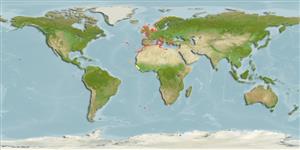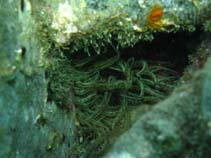Aiptasia mutabilis (Gravenhorst, 1831)
Trumpet anemone| Native range | All suitable habitat | Point map | Year 2050 |

|
| This map was computer-generated and has not yet been reviewed. |
| Aiptasia mutabilis AquaMaps Data sources: GBIF OBIS |
Classification / Names Common names | Synonyms | CoL | ITIS | WoRMS
Anthozoa | Actiniaria | Aiptasiidae
Environment: milieu / climate zone / depth range / distribution range Ecology
Sessile; depth range 0 - 50 m (Ref. 358). Subtropical
Distribution Countries | FAO areas | Ecosystems | Occurrences | Introductions
Atlantic and the Mediterranean: Azores Islands, Ireland to the Canary Islands.
Length at first maturity / Size / Weight / Age
Maturity: Lm ? range ? - ? cm
Short description Morphology
Diameter of the foot: 2.5 cm. Oral disc, tentacles not included/understood: 6 cm; cuts vertical, 20 cm. 136 tentacles: are laid out in 6 crowns around the siphonoglyphe; each one of them can measure up to 6 cm length. Coloring is fluctuating, rear related to the density of symbiotic algae, zooxanthella the, present ones within fabrics. The tentacles more or less transparent; and are avoided reasons in band or reticules, of white color to green, absent at ecotype I (Ref. 358).
Found on various rock funds, inside excavations and of cracks (Ref. 201). Known from infralittoral zones (Ref. 85338). Solitary (Ref. 2377).
Life cycle and mating behavior Maturity | Reproduction | Spawning | Eggs | Fecundity | Larvae
Members of the class Anthozoa are either gonochoric or hermaphroditic. Mature gametes are shed into the coelenteron and spawned through the mouth. Life cycle: The zygote develops into a planktonic planula larva. Metamorphosis begins with early morphogenesis of tentacles, septa and pharynx before larval settlement on the aboral end.
Main reference
References | Coordinator | Collaborators
Wirtz, P., O. Ocaña and T. Molodtsova. 2003. (Ref. 201)
IUCN Red List Status (Ref. 130435)
CITES status (Ref. 108899)
Not Evaluated
CMS (Ref. 116361)
Not Evaluated
Threat to humans
Human uses
| FishSource |
Tools
More information
Internet sources
BHL | BOLD Systems | CISTI | DiscoverLife | FAO(Publication : search) | Fishipedia | GenBank (genome, nucleotide) | GloBI | Gomexsi | Google Books | Google Scholar | Google | PubMed | Hexacorallians of the World | Tree of Life | Wikipedia (Go, Search) | Zoological Record
Estimates based on models
Preferred temperature
(Ref. 115969): 10.2 - 20.5, mean 15.3 (based on 226 cells).
Price category
(Ref. 80766):
Unknown.



